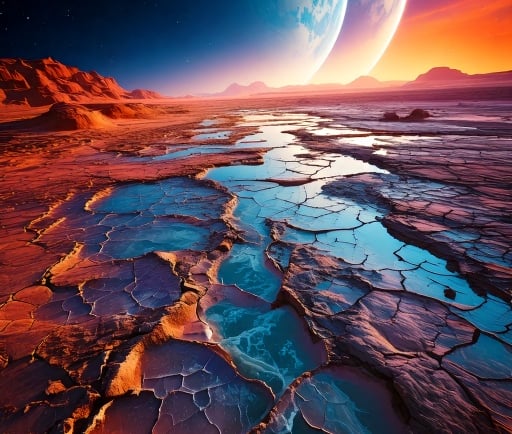The Intriguing Surfaces of Thin Cracked Crusts: Understanding Tidal Flexing and Geological Activities


Introduction to Thin Cracked Crusts
The surfaces of thin cracked crusts offer a fascinating glimpse into the dynamic processes that shape celestial bodies. Predominantly observed on exoplanets, these features result from a combination of tidal flexing and geological activities that are influenced by gravitational forces. Understanding these phenomena opens a gateway to insights about the composition and history of various celestial surfaces.
Tidal Flexing and Gravitational Forces
Tidal flexing occurs as a direct result of gravitational forces exerted by nearby massive objects. When two celestial bodies, such as a planet and its moon, orbit each other, variations in gravity cause significant stress on the planetary surface. This stress can lead to cracking, resulting in fissures that penetrate the crust. The interplay between gravity and the structural integrity of the crust is crucial in determining how these thin cracked surfaces develop.
Implications of Geological Activities
Geological activities also play an essential role in the formation of these cracked surfaces. Processes such as volcanic activity, tectonic shifts, and other geological doings can exacerbate the formation of fissures. When these cracks are breached due to geological processes, they can release gases such as hydrogen. Furthermore, in certain cases, these fissures may even serve as gateways to space, potentially allowing material and energy to escape into the cosmos.
The Presence of Basalt Samples on Exoplanets
Research indicates that basalt samples may frequently appear on the surfaces of various exoplanets. These volcanic rocks suggest that the geological history of these planets is rich and varied. The presence of thin cracked crusts, alongside basalt compositions, illustrates the ongoing geological processes even in distant worlds. Notably, exoplanets exhibiting these traits could provide compelling evidence about the possibility of life beyond our solar system.
Conclusion: The Future of Astrobiological Research
The study of thin cracked crusts and their relationship with tidal flexing and geological activities is paramount in the field of astrobiology. Understanding how these factors interact sheds light on the potential habitability of exoplanets. As research methods improve, the analysis of these surfaces may one day unveil the secrets held within distant worlds, leading to exciting discoveries about the existence of life and the nature of our universe.
